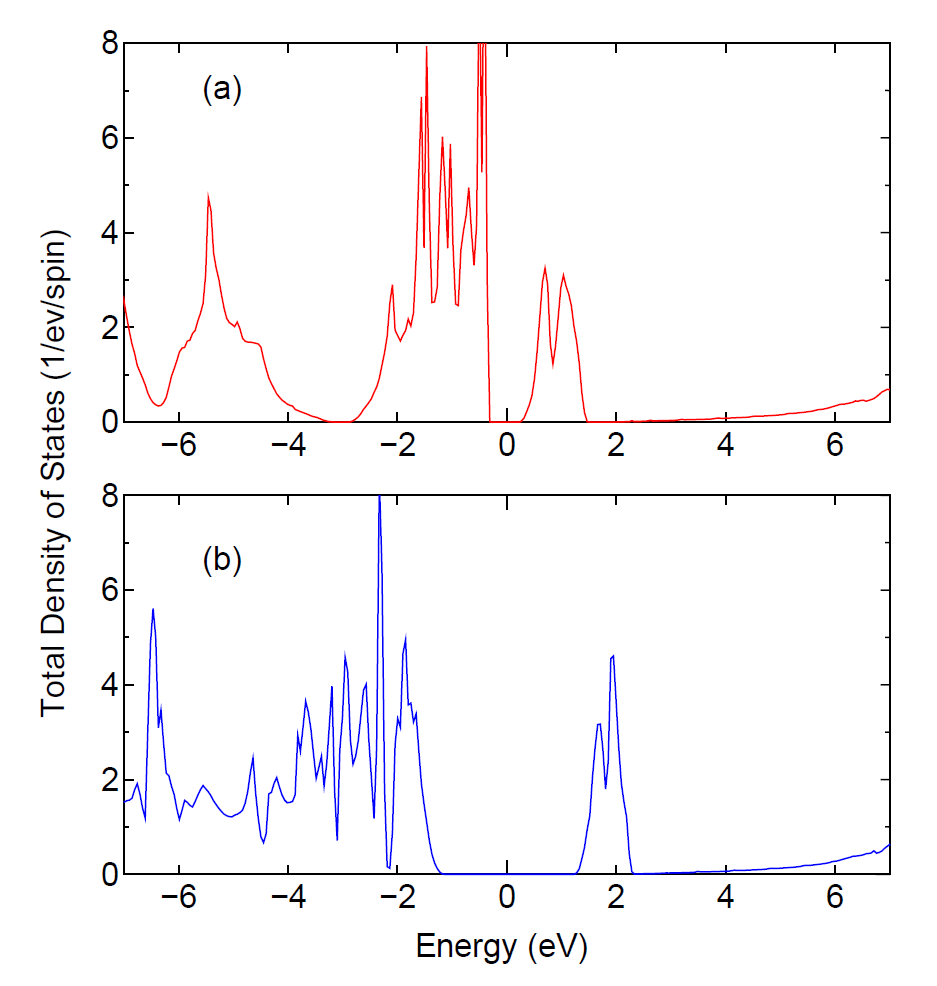Next: Constraint DFT for non-collinear Up: User's manual of OpenMX Previous: Orbital magnetic moment Contents Index
LDA+U methods with different definitions of the occupation number operator [18] are available for both the collinear and non-collinear calculations by the following keyword 'scf.Hubbard.U':
scf.Hubbard.U on # On|Off, default=off
It is noted that the LDA+U methods can be applied to not only LDA but also GGA.
The occupation number operator is specified by the following keyword
'scf.Hubbard.Occupation':
scf.Hubbard.Occupation dual # onsite|full|dual, default=dual
Among three occupation number operators, only the dual operator
satisfies a sum rule that the trace of occupation number matrix
gives the total number of electrons which is the most primitive
conserved quantity in a Hubbard model.
For the details of the operators onsite, full, and dual, see
Ref. [18].
The effective U-value in eV on each orbital of species defined by
<Definition.of.Atomic.Species
Ni Ni6.0S-s2p2d2 Ni_CA13S
O O5.0-s2p2d1 O_CA13
Definition.of.Atomic.Species>
is specified by
<Hubbard.U.values # eV
Ni 1s 0.0 2s 0.0 1p 0.0 2p 0.0 1d 4.0 2d 0.0
O 1s 0.0 2s 0.0 1p 0.0 2p 0.0 1d 0.0
Hubbard.U.values>
The beginning of the description must be '
***********************************************************
***********************************************************
Occupation Number in LDA+U and Constraint DFT
Eigenvalues and eigenvectors for a matrix consisting
of occupation numbers on each site
***********************************************************
***********************************************************
1 Ni
spin= 0
Sum = 8.591857905308
1 2 3 4 5 6 7 8
Individual -0.0024 0.0026 0.0026 0.0038 0.0051 0.0051 0.0888 0.0950
s 0 0.1671 0.0005 -0.0006 0.0040 0.0000 0.0005 -0.0124 0.0000
s 1 -0.9856 -0.0030 0.0039 -0.0227 -0.0000 -0.0072 0.0066 0.0000
px 0 0.0010 0.0004 0.0011 -0.0131 0.0004 0.0001 -0.0261 -0.0291
py 0 0.0010 0.0006 -0.0008 -0.0130 0.0000 0.0009 -0.0271 -0.0000
pz 0 0.0010 -0.0012 -0.0001 -0.0131 -0.0004 0.0001 -0.0261 0.0291
px 1 0.0067 0.0023 0.0066 -0.0792 -0.0161 0.0123 0.5594 0.7062
py 1 0.0068 0.0041 -0.0053 -0.0801 -0.0000 -0.0162 0.5797 0.0002
pz 1 0.0067 -0.0070 -0.0005 -0.0792 0.0161 0.0123 0.5594 -0.7063
d3z^2-r^2 0 0.0002 -0.0781 -0.0105 0.0002 0.0023 0.0014 0.0002 0.0108
dx^2-y^2 0 0.0004 -0.0105 0.0781 0.0004 -0.0013 0.0024 0.0003 -0.0062
dxy 0 0.0004 -0.0009 -0.0002 0.0246 -0.0421 -0.0251 0.0794 -0.0050
dxz 0 -0.0001 0.0008 -0.0010 0.0269 0.0000 0.0478 0.0795 0.0000
dyz 0 0.0004 0.0004 0.0008 0.0246 0.0420 -0.0251 0.0794 0.0050
d3z^2-r^2 1 -0.0023 0.9875 0.1327 -0.0033 -0.0262 -0.0159 -0.0001 -0.0069
dx^2-y^2 1 -0.0040 0.1326 -0.9875 -0.0056 0.0151 -0.0275 -0.0002 0.0040
dxy 1 0.0091 0.0233 0.0052 -0.5578 0.7055 0.4249 -0.0749 0.0157
dxz 1 0.0189 -0.0180 0.0233 -0.5964 -0.0003 -0.7958 -0.0748 -0.0000
dyz 1 0.0091 -0.0110 -0.0212 -0.5578 -0.7052 0.4255 -0.0749 -0.0157
9 10 11 12 13 14 15 16
Individual 0.0952 0.2456 0.9902 0.9974 0.9975 1.0060 1.0060 1.0137
s 0 0.0002 0.9859 -0.0036 -0.0001 0.0000 -0.0000 0.0000 -0.0000
.....
...
For collinear cases
<Atoms.SpeciesAndCoordinates # Unit=AU
1 Ni 0.0 0.0 0.0 10.0 6.0 on
2 Ni 3.94955 3.94955 0.0 6.0 10.0 on
3 O 3.94955 0.0 0.0 3.0 3.0 on
4 O 3.94955 3.94955 3.94955 3.0 3.0 on
Atoms.SpeciesAndCoordinates>
For non-collinear cases
<Atoms.SpeciesAndCoordinates # Unit=AU
1 Ni 0.0 0.0 0.0 10.0 6.0 40.0 10.0 0 on
2 Ni 3.94955 3.94955 0.0 6.0 10.0 40.0 10.0 0 on
3 O 3.94955 0.0 0.0 3.0 3.0 10.0 40.0 0 on
4 O 3.94955 3.94955 3.94955 3.0 3.0 10.0 40.0 0 on
Atoms.SpeciesAndCoordinates>
 |